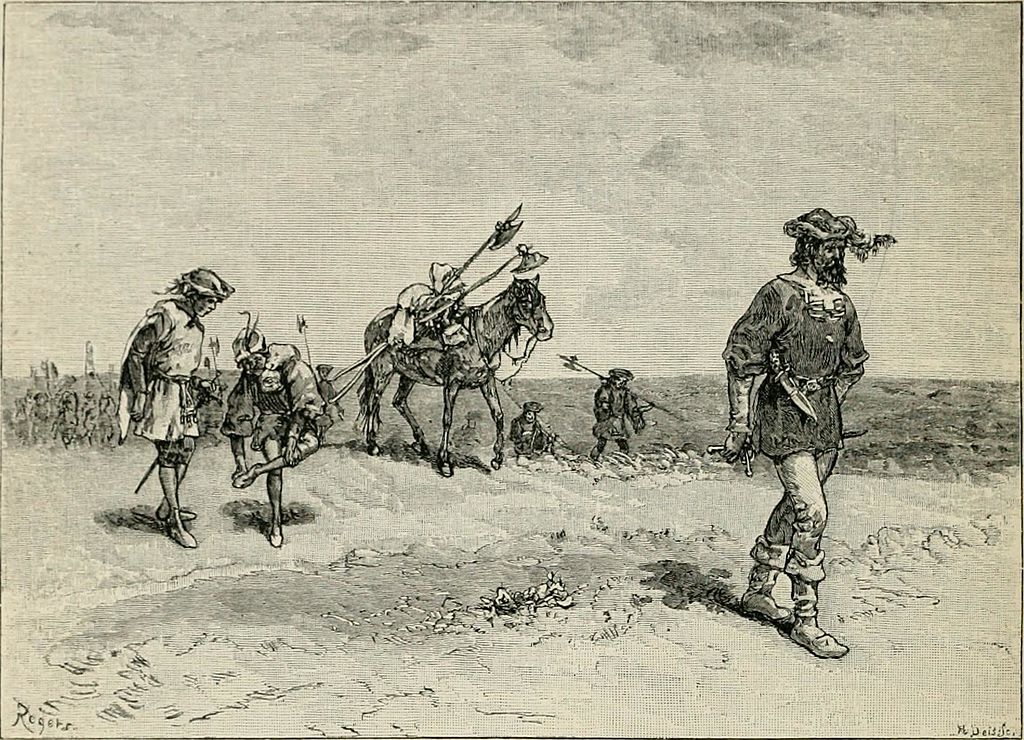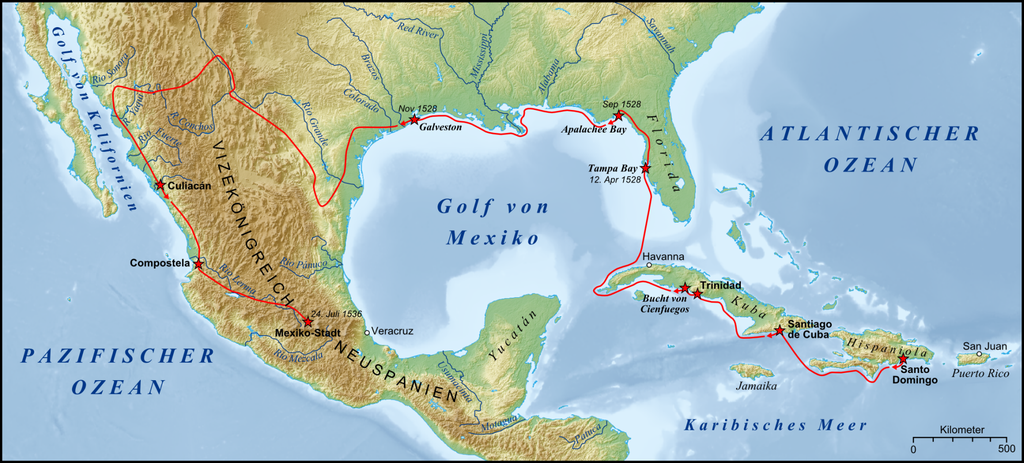305-Cast Away in the New World
Futility Closet
Greg Ross
4.8 • 748 Ratings
🗓️ 27 July 2020
⏱️ 31 minutes
🧾️ Download transcript
Summary

Marooned in Florida in 1528, four Spanish colonists made an extraordinary journey across the unexplored continent. Their experiences changed their conception of the New World and its people. In this week's episode of the Futility Closet podcast we'll describe the remarkable odyssey of Álvar Núñez Cabeza de Vaca and his reformed perspective on the Spanish conquest.
We'll also copy the Mona Lisa and puzzle over a deficient pinball machine.
Intro:
The Russian navy built two circular warships in 1871.
When shaken, a certain chemical solution will change from yellow to red to green.
Sources for our feature on Álvar Núñez Cabeza de Vaca:
Andrés Reséndez, A Land So Strange: The Epic Journey of Cabeza de Vaca, 2009.
Robin Varnum, Álvar Núñez Cabeza de Vaca: American Trailblazer, 2014.
Donald E. Chipman, Álvar Núñez Cabeza de Vaca: The 'Great Pedestrian' of North and South America, 2014.
Alex D. Krieger, We Came Naked and Barefoot: The Journey of Cabeza de Vaca Across North America, 2010.
Peter Stern, "Alvar Núñez Cabeza de Vaca: Conquistador and Sojourner," in Ian Kenneth Steele and Nancy Lee Rhoden, eds., The Human Tradition in Colonial America, 1999.
Rolena Adorno, "The Negotiation of Fear in Cabeza de Vaca's Naufragios," in Stephen Greenblatt, ed., New World Encounters, 1993.
Alvar Núñez Cabeza de Vaca, The Journey of Alvar Nuñez Cabeza de Vaca and His Companions From Florida to the Pacific, 1528-1536, 1542.
Andrés Reséndez, "A Desperate Trek Across America," American Heritage 58:5 (Fall 2008), 19-21.
Nancy P. Hickerson, "How Cabeza De Vaca Lived With, Worked Among, and Finally Left the Indians of Texas," Journal of Anthropological Research 54:2 (Summer 1998), 199-218.
Donald E. Chipman, "In Search of Cabeza de Vaca's Route Across Texas: An Historiographical Survey," Southwestern Historical Quarterly 91:2 (October 1987), 127-148.
Paul E. Hoffman, "A Land So Strange: The Epic Journey of Cabeza de Vaca, the Extraordinary Tale of a Shipwrecked Spaniard Who Walked Across America in the Sixteenth Century," Journal of American History 95:2 (September 2008), 496-497.
R.T.C. Goodwin, "Alvar Nunez Cabeza de Vaca and the Textual Travels of an American Miracle," Journal of Iberian & Latin American Studies 14:1 (April 2008), 1-12.
John L. Kessell, "A Land So Strange: The Epic Journey of Cabeza de Vaca," American Historical Review 113:5 (December 2008), 1519-1520.
Robert Wilson, "A Long Walk in the New World," American Scholar 77:1 (Winter 2008), 137-139.
Nan Goodman, "Mercantilism and Cultural Difference in Cabeza de Vaca's Relación," Early American Literature 40:2 (2005), 229-250, 405.
Ali Shehzad Zaidi, "The Spiritual Evolution of Cabeza de Vaca in Shipwrecks," Theory in Action 7:3 (July 2014), 109-117.
Kun Jong Lee, "Pauline Typology in Cabeza De Vaca's Naufragios," Early American Literature 34:3 (1999), 241-262.
"How Cabeza de Vaca, Explorer, Came by His Strange Name," New York Times, March 9, 1930.
Donald E. Chipman, "Cabeza de Vaca, Álvar Núñez," Texas State Historical Association (accessed July 12, 2020).
"The Journey of Alvar Nuñez Cabeza de Vaca," American Journeys Collection, Wisconsin Historical Society Digital Library and Archives, 2003.

Listener mail:
Wikipedia, "City of Death" (accessed July 17, 2020).
Encyclopaedia Britannica, "Cloud Seeding" (accessed July 17, 2020).
Wikipedia, "Cloud Seeding" (accessed July 17, 2020).
Andrew Moseman, "Does Cloud Seeding Work?", Scientific American, Feb. 19, 2009.
Janet Pelley, "Does Cloud Seeding Really Work?", Chemical & Engineering News 94:22 (May 30, 2016), 18-21.
Lulin Xue, Sarah A. Tessendorf, Eric Nelson, Roy Rasmussen, Daniel Breed, et al., "Implementation of a Silver Iodide Cloud-Seeding Parameterization in WRF. Part II: 3D Simulations of Actual Seeding Events and Sensitivity Tests," Journal of Applied Meteorology and Climatology 52:6 (June 2013), 1458-1476.
Rachel Hager, "Idaho Power Can Make It Snow — Increasing Water Reserves, Powering Homes. But Is It Safe?", Idaho Statesman, July 25, 2019.
This week's lateral thinking puzzle was contributed by listener Eric Waldow.
You can listen using the player above, download this episode directly, or subscribe on Google Podcasts, on Apple Podcasts, or via the RSS feed at https://futilitycloset.libsyn.com/rss.
Please consider becoming a patron of Futility Closet -- you can choose the amount you want to pledge, and we've set up some rewards to help thank you for your support. You can also make a one-time donation on the Support Us page of the Futility Closet website.
Many thanks to Doug Ross for the music in this episode.
If you have any questions or comments you can reach us at [email protected]. Thanks for listening!
Transcript
Click on a timestamp to play from that location
| 0:00.0 | Welcome to the Futility Closet Podcast, forgotten stories from the pages of history. |
| 0:14.9 | Visit us online to sample more than 11,000 quirky curiosities from circular warships to a chemical traffic light. |
| 0:22.4 | This is episode 305. I'm Greg Ross. And I'm Sharon Ross. Marooned in Florida in 1528, |
| 0:29.7 | four Spanish colonists made an extraordinary journey across the unexplored continent. |
| 0:34.8 | Their experiences changed their conception of the new world and its people. |
| 0:39.0 | In today's show, we'll describe the remarkable odyssey of Alvar Nunez Cabez-de-Vaca |
| 0:43.6 | and his reformed perspective on the Spanish conquest. We'll also copy the Mona Lisa |
| 0:49.0 | and puzzle over a deficient pinball machine. |
| 1:06.1 | In 1526, King Charles of Spain approved an expedition to explore and permanently occupy Spanish Florida, which was a large area stretching from modern Florida around the Gulf Coast to northern Mexico. |
| 1:12.6 | Five ships departed in June 1527, and after many reverses, they entered the Gulf and reached |
| 1:18.5 | the mainland, where the colonists disembarked and claimed the land for Spain. |
| 1:23.2 | They thought they were near their goal, Rio de Las Palmas, in modern Mexico, an area that was |
| 1:27.7 | valued for its strategic location and reputed riches. So the expedition's leader, Panfilo |
| 1:33.4 | de Narvaez, ordered that the able-bodied men and horses would proceed on foot toward Rio |
| 1:38.5 | de Las Palmas, which he hoped was not more than 30 or 45 miles away, while the crew members |
| 1:43.9 | and women would sail directly to the |
| 1:45.7 | mouth of the river and meet them there. That would have been a sensible plan, except that due to a |
| 1:50.6 | disastrous error, they had really landed near what is now Tampa Bay on the western coast of Florida. |
| 1:56.4 | They were 900 miles off target and didn't know it. As the ships sailed away, 300 colonists and 40 horses |
| 2:03.4 | were left stranded in a completely alien world. They headed north and walked for two weeks. When they |
| 2:09.7 | pressed the local indigenous people for food, they learned about a province called Appalachie, |
| 2:14.3 | far to the north, which held gold and valuables. They set out to find this, |
... |
Please login to see the full transcript.
Disclaimer: The podcast and artwork embedded on this page are from Greg Ross, and are the property of its owner and not affiliated with or endorsed by Tapesearch.
Generated transcripts are the property of Greg Ross and are distributed freely under the Fair Use doctrine. Transcripts generated by Tapesearch are not guaranteed to be accurate.
Copyright © Tapesearch 2025.

